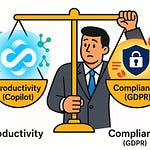Here’s a question: Is SharePoint still just an old document dump with complicated permissions—or has it become the engine powering collaboration in modern workplaces? Most people haven’t seen the leap it has made inside Microsoft 365. What SharePoint can do today is very different from what it did yesterday, and it’s exactly why so many organizations now build their digital workplace on top of it. So what changed—and why does it matter for your workflows? Let’s break it down in ways you probably haven’t seen before.
The Ghosts of Old SharePoint
Most IT pros remember SharePoint in its early years as the system that made storing documents feel like navigating a maze. You’d set up a site for a department, and before you knew it, half the team couldn’t find where their files went, while the other half couldn’t understand why they suddenly lost access. That memory lingers because for many people, the pains of old SharePoint felt like more than just technical hiccups—they felt like structural flaws in the platform itself. And once a tool gets stamped with that reputation, it tends to stick in an organization’s culture far longer than the product itself actually deserves.
Think back to when the interface looked like a patchwork of early-2000s websites. You had lists layered on top of document libraries, permissions stacked on permissions, and navigation menus tucked into places no end user would naturally find. IT admins often spent hours trying to explain to employees why a document library wasn’t the same as a folder structure, but to most users it just felt like extra steps between them and their files. The bigger problem wasn’t that SharePoint lacked features—it had plenty. The issue was that every step forward for flexibility seemed to add two steps of complexity.
Permissions management was easily the number one complaint. If you wanted to give one person access to a folder, you had to break inheritance. Then, if someone wanted access to part of that folder, you’d start layering exceptions, and suddenly the entire security model turned into spaghetti you couldn’t untangle. Departments often spun up sites on their own without understanding the long-term impact, and soon IT was faced with a patchwork of silos, each with its own rules. That’s when users started running into errors like, “Access denied,” or worse—finding documents that were supposed to remain private.
I remember one story from a mid-sized marketing department. They needed a workspace to manage campaign assets, so they asked IT for a SharePoint site. Within a month, everyone had their own version of access levels: some as contributors, some as viewers, some as site owners. When a new employee joined, no one knew which group to place them in, so permissions were copied, pasted, and improvised. By the second quarter, files were going missing, restricted reports were viewable by interns, and no one could track which version of a campaign document was the latest. Instead of helping collaboration, the site created confusion—and that story is far from uncommon.
The reputation problem wasn’t just anecdotal either. Blogs and IT forums from the 2010s are filled with admins describing SharePoint as “the product everyone is forced to use but no one enjoys.” Adoption surveys from that era consistently ranked SharePoint at the bottom of collaboration tools, and much of the feedback revolved around the same themes: confusing interface, permissions chaos, and the fact that training never seemed to stick. Even people with years of experience administering the platform admitted they often leaned on third-party tools because SharePoint out of the box felt incomplete or hard to manage.
Because of that legacy, many organizations still carry strong feelings about SharePoint, even if they haven’t touched the modern version. Leaders who used it back in 2012 assume it’s still the same clunky system in 2024. That perception gap has real consequences. Teams delay projects because they believe switching to SharePoint means endless training sessions and frustrated employees. Companies invest in other platforms, not realizing the tools they already pay for inside Microsoft 365 might actually do the job better. In some cases, this misunderstanding is so deep that when IT suggests SharePoint, decision-makers push back before even hearing what’s changed.
The misconception is powerful because no one likes repeating history. If your memory of SharePoint is tied to hours wasted on broken navigation or permissions that constantly backfired, it’s natural to resist. But here’s where things take a turn. Modern SharePoint has shed almost all of those legacy problems. Permissions are simpler, navigation resembles modern web design, and the look-and-feel aligns with the rest of Microsoft 365 instead of feeling like its own disconnected world. It’s not the same maze that kept users lost for years.
Understanding this shift is critical because we’re not just talking about small tweaks. We’re talking about a product that has been completely reimagined—technically, visually, and strategically. And this transformation isn’t happening in isolation, it’s happening as part of Microsoft 365 as a whole. Which means when we think of SharePoint today, we’re not just thinking about document libraries. We’re thinking about an engine working quietly behind the tools millions of people rely on daily. And that reinvention positions SharePoint right in the center of the modern digital workplace, even if most users don’t realize it yet.
SharePoint’s New Role in Microsoft 365
What if SharePoint isn’t just a storage closet anymore, but the foundation of your entire digital workplace? That question usually catches people off guard, because for years SharePoint had the image of being a place you went only when you needed to stash files that didn’t fit anywhere else. But the reality now looks very different. Today, SharePoint doesn’t sit off to the side as a standalone platform. It’s embedded right into Microsoft 365, playing a role that’s far less visible but much more essential. And if you use Teams, OneDrive, or even Viva, you’re already leaning on SharePoint without necessarily realizing it.
Here’s the tension: most people see Teams as the central hub where work happens. They chat, they call, they share files, and they assume Teams is the engine running those processes. But that’s only part of the story. If you peel back the layers, the backbone holding those files, permissions, and collaborative workspaces together is SharePoint. Without it, Teams chat threads wouldn’t have a reliable place to store documents, and groups would lose their structure as soon as you tried to scale collaboration beyond messaging.
Take a simple example. You create a brand-new Team for a project. The interface you see is all friendly—channels, conversation spaces, and file tabs. But the moment you hit “create,” Microsoft 365 quietly spins up a full SharePoint site in the background. That site doesn’t just exist as a storage bin. It acts as the structured container for permissions, version history, and the document library that powers the “Files” experience in Teams. When users drag a document into a channel, they think it’s going into Teams, but in reality, Teams is simply giving them a window into a SharePoint library.
Once you recognize that, you start to see SharePoint’s real role in context. It isn’t competing with Teams, it’s enabling it. SharePoint now functions like the fabric connecting multiple layers of Microsoft 365. It powers your intranet pages where announcements live, it holds the files that OneDrive surfaces, and it underpins the workspaces tied to Microsoft 365 Groups. That means when you’re communicating in Teams, reviewing data in Viva, or automating processes through Power Automate, there’s a strong chance the content and governance pieces are sitting safely inside SharePoint.
And this isn’t just about file storage. SharePoint has integrations that extend far into the platform. With Viva, SharePoint pages feed into employee experiences like company news, resource hubs, and personalized dashboards. With Power Automate, you can attach workflows that trigger when documents are uploaded, when metadata is updated, or when approvals are required. Even OneDrive, which many people think of as its own distinct app, actually leans on SharePoint’s document library infrastructure. What looks like personal storage on the surface is still grounded in the same architecture.
It’s worth pointing out how much this changes the misconception that SharePoint and Teams are competing for attention. They’re often positioned side by side in presentations, as if you’re supposed to choose one or the other. But that’s misleading. Teams provides the interface—the conversation and collaboration layer. SharePoint provides the structured, governed, and scalable content layer underneath. Without both working in tandem, neither tool would deliver the complete picture of modern collaboration.
The hidden role that SharePoint plays raises an important thought: if this platform is running quietly behind almost every major Microsoft 365 service, what does that mean for its actual value? For years, SharePoint was treated like an optional add-on. Today it’s mandatory if you want the rest of the ecosystem to function predictably. You may not see it on your screen in the same way you see Teams, but it’s the scaffolding holding the workspace together.
It becomes especially clear when organizations try to bypass SharePoint by adding third-party file systems and integrations. Almost immediately, they run into issues: Teams doesn’t sync correctly, workflows can’t find the right triggers, and administration becomes fragmented. That’s because the design of Microsoft 365 assumes SharePoint is silently doing its job in the background. If you take it out of the equation, the rest of the structure starts to wobble.
So the big shift here is visibility. SharePoint of the past demanded attention from end users, often painfully so. Modern SharePoint is still central, but users don’t always notice it because it’s been absorbed into the everyday tools they prefer. You can think of it as the plumbing in a building. No one talks about it, but everyone depends on it. And that shift makes it indispensable, even if it doesn’t get the recognition that Teams or Outlook usually receive.
The key takeaway is that SharePoint has moved from being front and center to being foundational. It doesn’t need to announce itself, because the value shows up every time a file is shared seamlessly in Teams, every time an intranet delivers the right news to the right audience, and every time an automated workflow runs without breaking. Which leads to an obvious question: if SharePoint really is the backbone of Microsoft 365, where do users actually feel that impact in their daily work? That’s where we turn next.
From Document Dump to Productivity Engine
What changed that turned SharePoint from the clunky filing cabinet everyone avoided into a platform people actually want to use? The shift isn’t just about technology upgrades. It’s about completely rethinking how information flows inside an organization. SharePoint used to be a place where files went to disappear. Now it’s positioning itself as a productivity engine that not only stores information but actively helps people surface it, connect it with business processes, and interact with it in real time.
If you remember the early versions, the backbone was site collections and document libraries. They worked, but they were rigid. You could upload files, create lists, and configure some workflows, but the experience was static. There was little incentive for employees to engage beyond using it as a required storage space. Fast forward to today, and the same platform has turned into a modern intranet system. It delivers pages, dynamic web parts, and integrations that do more than hold documents—they contextualize them. Instead of employees digging through folder paths, content can surface based on relevance, project stage, or user role.
The old repositories felt like warehouses without signage. Today’s SharePoint can serve up the right document on the homepage of a project site, highlight recent updates, and even show related conversations happening in Teams. Libraries aren’t just storage anymore. They’re tied to metadata, version control, and automated processes that make them living resources. For example, when someone uploads a contract, Power Automate can instantly route it to an approver, notify stakeholders, and archive the signed copy in a compliance-ready folder. Work that used to rely on dozens of emails or manual tracking now happens by design, without extra effort from the end user.
Another area that marks the contrast is how SharePoint handles communication. Old sites often looked like endless lists. Modern SharePoint uses pages that look and feel like any modern website. You can add news feeds, embed Power BI dashboards, drop in a Yammer or Teams conversation, or pull data from external systems—all on a single landing page. What used to look like a static portal now feels like an active workspace that employees visit not just to grab documents, but to keep up with activity across the business. It’s a subtle shift, but it transforms user perception from “this is where I save things” to “this is where I understand what’s happening.”
Design is part of why this evolution sticks. The interface is finally mobile-friendly, and you no longer need special training to find and manage content. Navigation isn’t buried three clicks deep. It behaves like any other modern site—clean layouts, responsive design, menus that make sense. That matters because the easier it is to use, the less burden falls on IT to provide constant hand holding. In the past, whole training sessions focused on “how to upload a document.” Now, users drop files into Teams or into the modern SharePoint interface and feel right at home.
Consider how departments are applying this in practice. HR teams set up onboarding portals where a new hire can find policy documents, watch training videos, and complete required tasks—all from a single SharePoint page. Legal departments centralize policy hubs with conditional access, so contractors see only what applies to them while employees see the full library. Project managers spin up workspaces where schedules, documents, dashboards, and conversations live side by side. Each example shows how SharePoint is moving beyond file storage into something that connects information directly with day-to-day workflows.
What you end up with is a tool that doesn’t just store knowledge but makes it usable. The old version often added friction. The modern version reduces it by making sure information is delivered in-context. Take the onboarding example again. In the past, employees waited for emails with attachments. Now, SharePoint handles it by giving them a portal with structured steps, dynamic updates, and automation that checks off progress. That reduces email traffic and shortens the time before a new employee becomes productive. IT doesn’t have to build custom solutions for each use case; SharePoint’s modern features are designed for self-service.
The big difference is visibility and value for the end user. If a tool requires constant training, users avoid it. If it saves them time, they adopt it naturally. Modern SharePoint crosses that line. It’s accessible enough for non-technical staff to use confidently, and flexible enough to scale for enterprise needs. That mix is something the old SharePoint never fully accomplished.
So instead of being a passive container, SharePoint now acts as an active driver of productivity. It pushes out updates, automates workflows, and connects with the broader Microsoft 365 ecosystem in ways that reduce redundancy and improve knowledge sharing. The shift is fundamental: it’s no longer about where you dump files, but how the platform shapes the way people work. And once you start looking at it through that lens, you can see how it creates measurable efficiency across departments. That’s where the most compelling real-world scenarios come into play.
Real-World Wins with Modern SharePoint
How do real organizations actually use modern SharePoint to deliver results? That’s the thing most IT leaders want to see before they buy into the idea that this isn’t the same platform they tried years ago. Examples matter, because if all you hear is high-level talk about “collaboration” and “intranets,” it sounds like just another round of marketing promises. But the practical outcomes are already out there, and they look very different from the old days of SharePoint sites gathering digital dust.
One of the clearest examples is HR onboarding. In the past, a new employee would start and instantly get buried in email threads, each one carrying some attachment they were expected to read, sign, or submit. Half the time, the latest version of a form wasn’t even attached, because managers kept sending older files from their inbox. Modern SharePoint changes that by centralizing everything into a portal. The HR department sets up a single SharePoint page where the new hire finds policies, training materials, and checklists. Tasks can be tracked, documents are version controlled, and approvals can be automated. For the employee, it means less chaos in their inbox. For HR, it means less time chasing down missing paperwork. And for management, it means new staff can start producing value days earlier than before, because they’re not stuck waiting on process gaps.
Another organization used SharePoint as part of its performance reporting. They needed a central place for executives to see company-wide metrics without sifting through multiple files scattered across departments. By combining a SharePoint hub with embedded Power BI dashboards, they built a single site that reports on sales numbers, project timelines, and resource allocation. Instead of emailing spreadsheets every Friday and worrying about which one was most up to date, everyone visits the portal and sees live data pulled straight into the dashboard. It’s simpler for users, it reduces duplication of effort, and importantly, it cuts down the risk of people making decisions based on outdated information. This is a type of efficiency win you just couldn’t achieve with the older, static version of SharePoint.
Compliance-heavy industries give us another angle, particularly when it comes to external sharing. In previous versions, giving someone outside the company access was a juggling act of permissions, sometimes ending in links that didn’t work or worse—links that granted too much. Modern SharePoint is tied tightly into Microsoft 365’s sensitivity labels, conditional access, and streamlined permission flows. That means IT can enforce policies where some documents can never leave the organization, while others can be shared in a controlled way. End users don’t need to decode complicated permission structures. They simply try to share, and SharePoint guides them to the right option based on the rules already in place. For industries like legal, financial, or healthcare, this kind of guardrail is the difference between safe collaboration and a compliance risk.
What’s striking across these examples is the measurable improvement. Workflows don’t just move faster—they’re cleaner. Fewer duplicate files means fewer mistakes. Knowledge search surfaces useful information because documents live in structured libraries instead of random folders. Time wasted on email chains or hunting down the “latest version” of a document drops sharply. And none of this requires the user to think, “I’m in SharePoint right now.” They often feel like they’re just using Teams, because much of the content layer is surfaced directly through Teams channels. That invisibility is actually a strength; when the platform is doing its job well, the collaboration looks seamless, not branded.
The skepticism from IT leaders understandably comes from history. Old SharePoint created overhead, not relief. But the current version flips that. Departments can spin up their own intranet portals, knowledge bases, or project hubs without weeks of IT handholding. At the same time, IT doesn’t lose control. The guardrails are built into the Microsoft 365 fabric, so governance is consistent across the board. What users see is freedom. What IT sees is compliance and structure. That combination is what makes the modern SharePoint model work, because it balances both perspectives without repeating the chaos of old site sprawl.
So this isn’t theory—it’s already playing out in HR, in reporting, in compliance scenarios, and in everyday project management. Modern SharePoint has moved from being the tool everyone tolerated to the fabric that holds together real-world workflows. And once you understand that, the question shifts from whether SharePoint has improved to how you’ll handle the governance model that comes with it.
Governance and Usability Made Manageable
Remember when SharePoint permissions felt like solving a Rubik’s cube blindfolded? That’s not the case anymore, and that’s one of the biggest shifts for admins who’ve been around long enough to remember the old days. Back then, giving someone access to a site or even a single library often led to cascading headaches. Break inheritance here, add unique permissions there, and suddenly you had no idea who could see what. It wasn’t unusual for an admin to spend half a day trying to unravel why an intern could access financial reports but the department lead couldn’t. That kind of complexity gave SharePoint a bad name among IT teams. And it’s why many admins still hesitate when they hear the word “migration.” They’re not worried about the technical move—they’re worried about reliving those permission nightmares.
Here’s the thing though: modern SharePoint’s permission model doesn’t play by those old rules anymore. Instead of custom-access scenarios multiplying across every site collection, access is now tied tightly into Microsoft 365 Groups. It means permissions are role-based and predictable. Add a user to the team or group, and they inherit the right level of access across SharePoint, Teams, and Outlook automatically. You’re no longer juggling site owners, members, contributors, and viewers in separate silos. The access model doesn’t just simplify onboarding and offboarding—it also makes governance more consistent across the tenant.
Admins who left SharePoint behind years ago often don’t realize just how much this alignment with Microsoft 365 has changed the playing field. The same Groups that drive collaboration in Teams are what drive permissions in SharePoint. That gives IT a single language to manage access across services. And layered on top of that are tools that didn’t exist in the old SharePoint era, like sensitivity labels, data loss prevention policies, and conditional access. Instead of relying on a tangle of SharePoint-specific rules, security now plugs into Microsoft 365’s enterprise-wide compliance framework. That’s a whole different mindset: instead of patching gaps one site at a time, admins set policies once and trust the platform to apply them consistently.
Just as important is the usability of the admin side. The old central admin pages felt like an obstacle course—menus spread across multiple pages, each with settings buried three or four clicks deep. The modern SharePoint admin center is far cleaner. You can see at a glance how sites are connected, how storage is being used, and where potential issues exist. Audit trails are easier to run, and reporting doesn’t feel bolted on. And if something does go wrong, you don’t have to hunt across different interfaces just to confirm a user’s permissions. That kind of visibility matters because admins can spend less time firefighting and more time shaping policies that improve the overall environment.
From the end user’s perspective, sharing has also lost a lot of its complexity. Years ago, sending someone a link was risky—would it even work, and what parts of the library were exposed? Today, sharing is simplified to a predictable experience that aligns across SharePoint and OneDrive. Users pick whether to share with specific people, groups, or the entire organization, and behind the scenes sensitivity labels enforce whether that’s even allowed. For IT, that consistency translates into fewer support tickets and far less cleanup of accidental oversharing. For end users, it builds trust that when they click “share,” they aren’t creating a problem for security.
The contrast is sharp. Old SharePoint made security feel like an afterthought to usability; the new model builds security into every workflow in patterns that admins and users can predict. Instead of endless exceptions, there are guardrails that work the same way across the suite. That reliability is what reduces both risk and frustration. It doesn’t mean admins have lost flexibility, but it does mean the system is less fragile—less likely to implode when someone adds the wrong person to a permissions list.
The benefit in practice is time. Admins aren’t spending days troubleshooting why user A can’t open a document that user B swears they just shared. They’re able to enforce policies broadly, identify outliers quickly, and move on. The firefighting mentality of old SharePoint gets replaced by proactive governance. And once security is aligned with the broader Microsoft 365 model, scaling becomes feasible. Large organizations that once struggled with thousands of unique permission sets can now operate with clearer, simpler structures.
That’s the real payoff here: SharePoint is no longer a governance liability. It’s manageable at scale, secure by design, and consistent with the wider Microsoft 365 environment you’re already running. And that brings us to the bigger picture—when governance stops being a roadblock, SharePoint can finally take its place as the backbone of organizational productivity moving forward.
Conclusion
SharePoint isn’t yesterday’s headache anymore—it’s become the backbone quietly powering Microsoft 365. The old frustrations with broken permissions and clunky sites don’t match the reality of what’s available today. Now it’s the system that keeps Teams, OneDrive, and intranets running smoothly, while giving organizations structure instead of chaos.
If you’re still running processes the long way—sending endless attachments, duplicating files, or relying on scattered hubs—it’s worth asking if SharePoint already has a smarter path built in. The missed opportunity isn’t fighting through old SharePoint issues. It’s ignoring the modern version that’s already sitting in your tenant.











